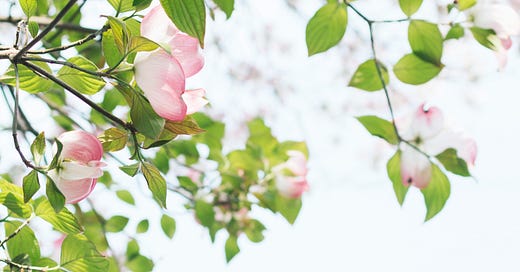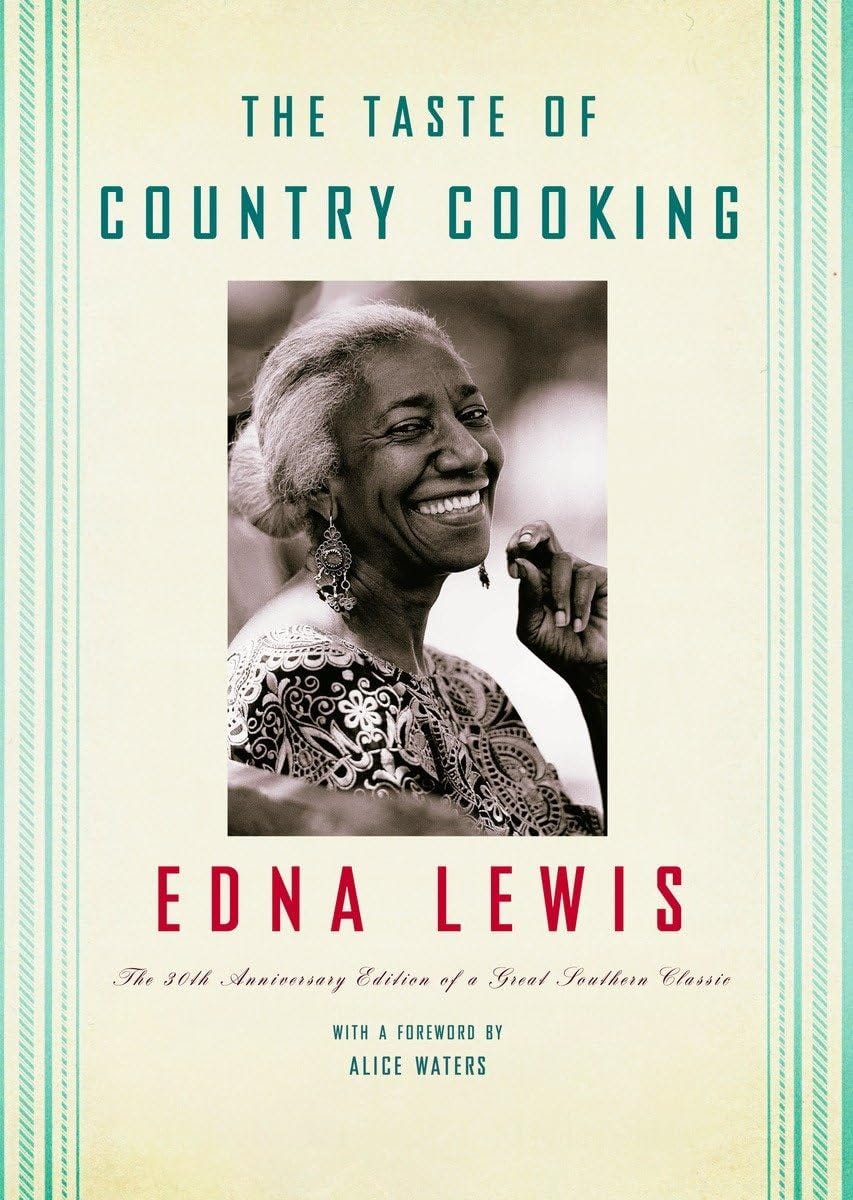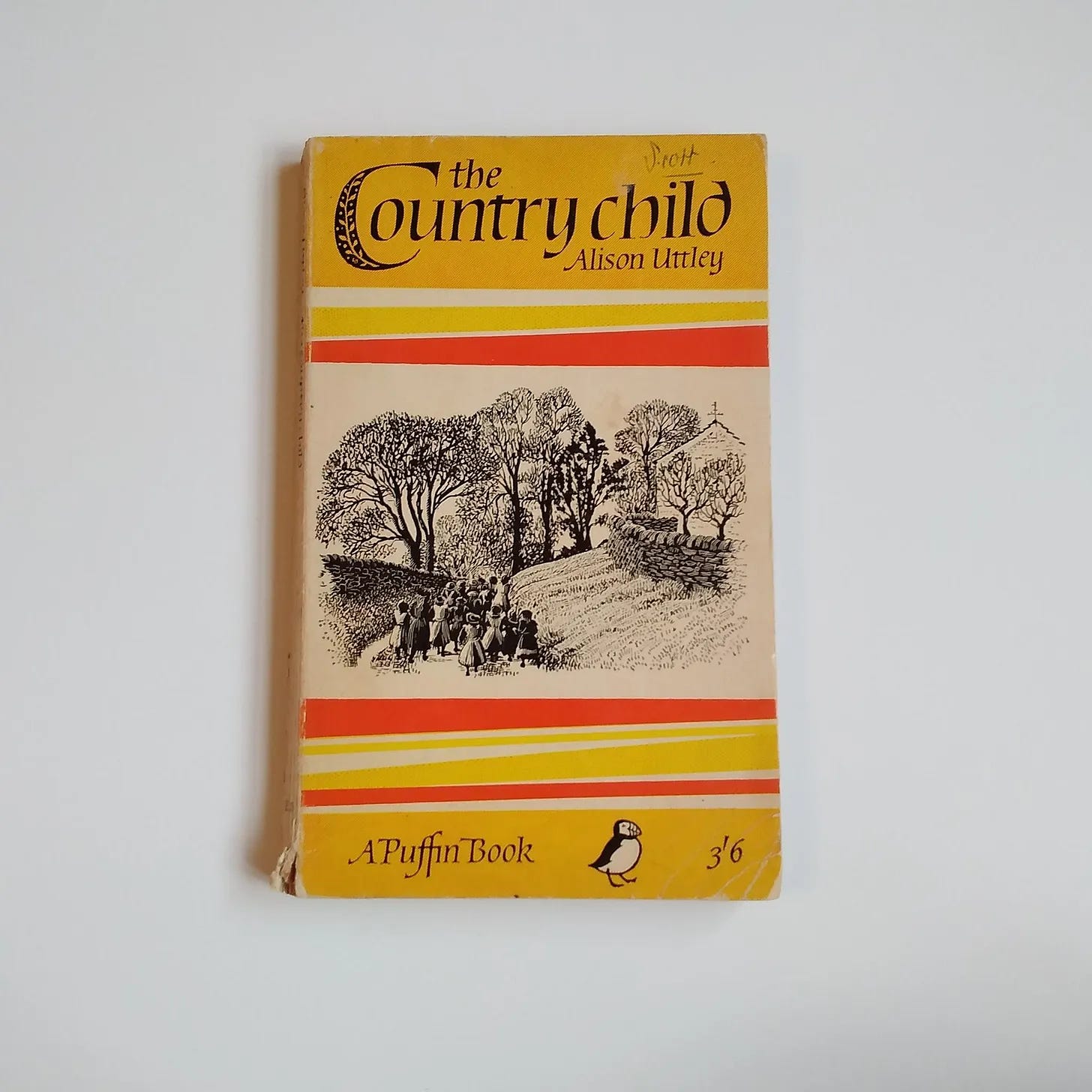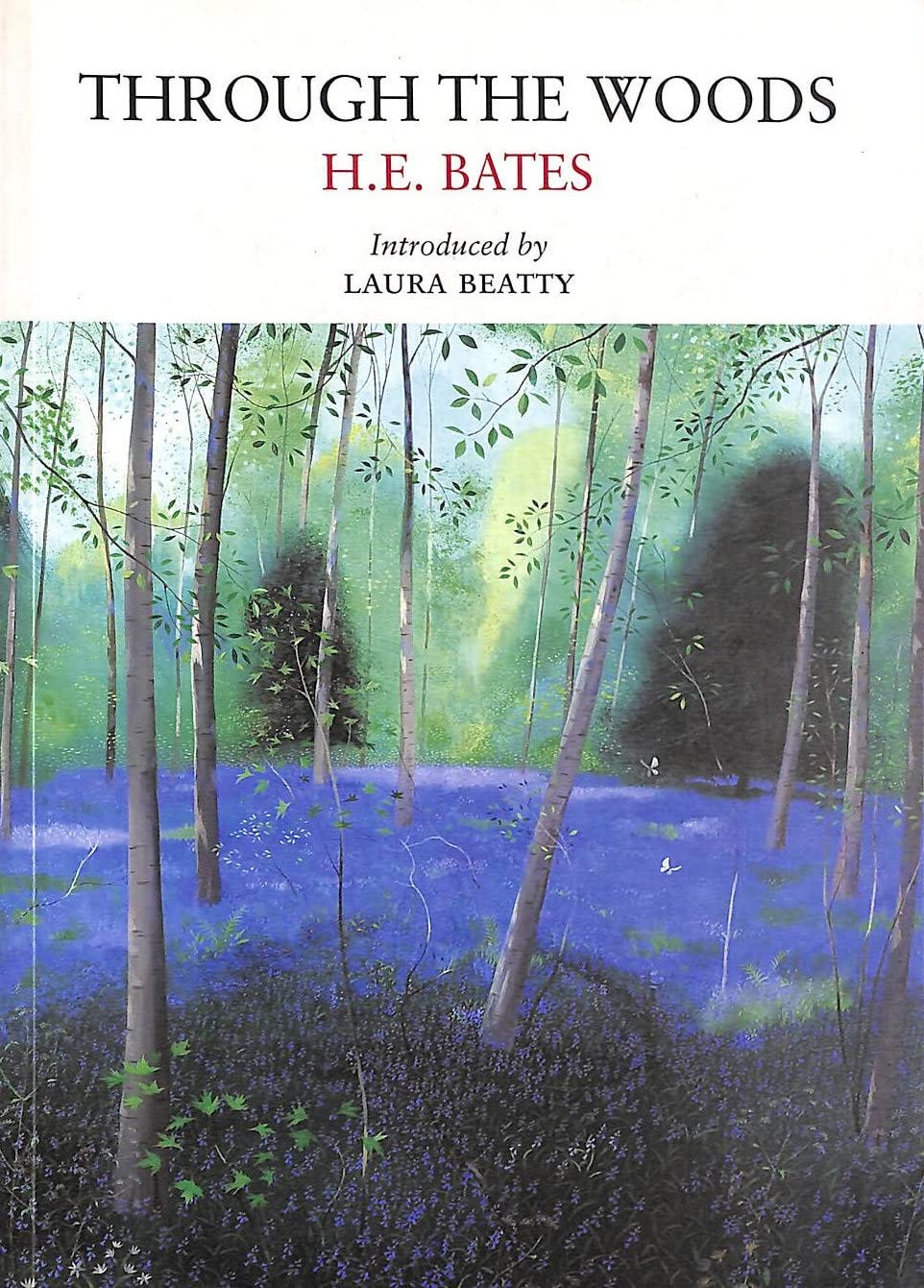To every thing there is a season, and a time to every purpose under the heaven (Ecclesiastes 3:1-8). I have a habit I call ‘seasonal rereading’ where I reread much-loved books, some in full, others in part. What books do you return to at this time of year? What new traditions are you establishing? Here are some of mine.
Spring is for rereading Edna Lewis’s The Taste of Country Cooking: “A stream, filled with the melted snows of winter, would flow quietly by us, gurgling softly and gently pulling the leaf of a fern that hung lazily from the side of its bank”, she writes. One of the only times the Lewis family ate fish was in spring when the shad began to run, soaking the fillets in salted water and patting them dry before rolling them in seasoned cornmeal to fry in home-rendered lard with a slice of smoked shoulder for extra flavour at breakfast time. She remembers following her father’s plough collecting sassafras roots turned up by the blade to steep for tea. English peas were grown to be served in heavy cream with new-season chicken. They’d gather wild honey from tree hollows and pick tiny strawberries and bake cookies, biscuits, cakes or junkets, custards and blancmanges enriched with cream, butter and buttermilk from their cows. The Spring chapter subheadings are descriptively beautiful: An Early Spring Dinner After Sheep-Shearing; A Spring Breakfast When the Shad Were Running; A Late Spring Lunch After Wild Mushroom Picking; A Late Spring Dinner with Spring-Hatched Chicken; A Hearty Midday Dinner.
Spring is also for rereading the spring chapters in Alison Uttley’s The Country Child:
“One morning Susan looked out of her window and saw that spring had really come. She could smell it and she put her head far out until she could touch the budding elm twigs. She pressed her hands on the rough stone of the window-sill to keep herself from falling as she took in deep draughts of the wine-filled air. It was the elder; the sap was rushing up the pithy stems, the young leaves had pierced the buds and now stuck out like green ears listening to the sounds of spring. The rich heady smell from the pale speckled branches came in waves borne by soft winds, mixed with the pungent odour of young nettles and dock.”
Late that day, Susan invited her entire class to tea to see her Easter egg. Margaret, her mother, who had granted Susan permission to invite one friend, was aghast but set to work buttering a week’s worth of home-baked bread, boiling four dozen eggs, and plating brandy snaps, slicing three plum cakes and dozens of apple pasties and currant slices. Uttley’s description of the farmhouse’s vast collection of cups, mugs and glasses and Margaret’s method of allocating each child with a drinking vessel is a joy:
“There were Jubilee mugs and gold lustre mugs, an old china mug with ‘Susan Garland, 1840’ on it, and several with, “ A present for a Good Girl’. There were mugs with views and mugs with wreaths of pink and blue flowers, with mottos and proverbs, with old men in high hats and women in wide skirts. There were tin mugs which belonged to the Irishmen, and Sheffield plated mugs from the mantelpiece, pewter and earthenware. There were delicate cups of lovely china, decorated with flowers and birds, blue Wedgwood, and some Spode breakfast cups, besides little basins and fluted bowls. Margaret gave out the cups and mugs herself, choosing clean, careful-looking girls for her best china. The social position of each girl could be detected at once from the kind of cup she had, which was unlike Margaret’s usual procedure, but this was an exceptional occasion. If only they had been round a table she would have trusted them, but now she had to use her judgment.”
I’ve just bought an elderly copy of The Farm on the Hill, Uttley’s follow-up (of sorts) to The Country Child, the latter found in Sudbury library when I was around ten, and kept out on loan for the best part of a year until I bought my own copy. I know much of it by heart. The Country Child and its sequel are lightly fictionalised accounts of Uttley’s childhood at Castletop Farm in the Peak District. Uttley's descriptions of country life and ability to inhabit Susan Garland, her young self, to recreate the fanciful, vivid imagination of a child who grew to be a scientist and great writer are unparalleled. Her background as a physics graduate and scientist doesn't subsume her mystical and spiritual wonder at the Derbyshire landscape and rhythms of farm life.
The Farm on the Hill feels a little more personal; Susan Garland’s pain at being denied a scholarship to the grammar school because, being female, she hasn’t been taught history at the village school and is therefore unable to answer questions on the subject in her qualifying exams is raw. Her parents, schoolmaster, and wider family are outraged. Eventually, Susan receives a scholarship by default after one of the boys refuses his place: “Her heart beat wildly; heaven was there with doors which would unlock with the key of scholarship. The golden gates would fly apart and she would step into that world of books and language, and the knowledge of echoes and sound and lightning which the schoolmaster called "science.”
The realities of running a farmhouse aren’t ignored. It’s relentless work. Susan notices housekeeper Becky’s body odour as they take a moment to admire the view from a guest bedroom window. Becky rarely has a moment to spare for herself, but Uttley gives her space; the housekeeper’s commentary is unmediated by Uttley’s narration, we hear firsthand about her workload, hopes, political and religious beliefs: “It wouldn’t be fair if the rich got to heaven. They’ve had their time on this earth. They can’t expect to have another life of doing nothing,” she mutters as she sweats in the August heat over a roasting pan of beef in a fierce oven, and get a glimpse of her sensuality and sexuality: “Becky felt the urge of life within her, She stretched up her arms and her round breasts nearly burst her tight bodice. She felt strong as a horse, eager to be off.”
Farm life is earthy, often sensual, and frequently visceral. Readers are not spared. Uttley's account of pig slaughter time made me feel sick with anxiety; it is brilliantly written, contrasting Susan’s distress with Becky’s hardened joking and the farmworkers’ deployment of task efficiency and well-rehearsed rituals as a coping strategy; they sublimate their distaste. But the pigs have become Susan’s friends, and she grieves their slaughter until their earthly forms are transformed beyond recognition. Over eight pages in The Farm on the Hill, Uttley describes how the Garland family processes its pork. Joints are wrapped in linen and dropped into huge market baskets. There’s a little basket of choice dainties for a poor widow carried by Margaret, Susan’s mother, on the journey by pony and trap into the village to deliver pork orders. Pigs’ trotters are cooked to a jelly. Black puddings boil in enormous kettles. Spiced brawns, yards of sausages, and sides of bacon dripping with brine are cured in the kitchen. Lard is poured into huge crocks, and nutty pieces of fat rendered into cracklings. Margaret and Becky make pork pies decorated with pastry rose petals and triangular pastries for farm workers. A pig’s bladder is cured to be turned into a football.
The stories of H.E. Bates, Alison Uttley, Joan Aitken, Laura Ingalls Wilder and Enid Blyton all have a strong sense of rural and urban place. They encouraged me to scrooch down and look at what is half hidden in a hedgerow, shadowed behind a tree, or lurking below the surface of a river. I began to look into windows and wonder what lay behind their curtains, and wandered the town hoping to catch a pie cooling on a windowsill, or a tall chocolate cake sitting on a kitchen table. I lifted stones and sat for hours in the woods, waiting for the tree spirits, fairies and elves to reveal themselves. I mostly blame Blyton for the latter; she was fanciful, although Uttley was no slouch in this department either. Blyton’s streams are sailed by elves in boats made from leaves, and her world populated by toads who made blue paint from harebells, bluebells and scrapings from the sky on a sunny day. She drew my attention to wallflowers growing from dry stone walls, writing how they were seeded from a necklace of brown and yellow gems, broken by an elf called Gillie (hence: ‘gillieflowers’). She wrote of fairies working in ribbon shops who used their rolling skills to curl up the delicate fronds of ferns to please the fairy king and queen. I would slowly uncurl the fronds of a shuttlecock fern and watch them spring back. I never saw one of Blyton’s imps riding lacewings as you or I would ride a horse but I didn’t tire of hoping that one day I might.
At first glance, H.E. Bates’s series, The Darling Buds of May seems like a lightly frothy account of a family living in rural Kent in the fifties, and the TV series only adds to this impression. But Pa and Ma Larkin are unmarried, unbothered by social convention (in the first chapter, we learn that 17 year-old Mariette, their eldest daughter, may be pregnant and the father unknown), are longterm tax avoiders with an indeterminate income, and live on a smallholding-cum-scrapyard where 90% of their time is spent eating or cooking lavish, homecooked English-style meals and romping around the (admittedly bucolic) countryside with an assortment of eccentric locals. Charlie, the young tax inspector’s first experience of the family’s lavishness is at the tea table with its centrepiece of three pineapples that hark back to a time when pineapples were an object of wealthy largesse and desire, plates of fish and chips, coloured blocks of ice cream (the family have already gorged on giant cones piled high with vanilla, raspberry and chocolate ice cream), pots of raspberry and strawberry jam, bottles of Worcestershire sauce and cups of tea, chocolate biscuits and piles of icy buns. The curtains are half-drawn, the TV is on, kids and animals are everywhere, and the kitchen radio plays jazz. Sardines are brought to the table, then pint jugs of cream to pour over thick slices of pineapple carved by Mariette, whose comely (and possibly pregnant) body further taunts the shy young man. Ma handfeeds the kittens with cream from her fingers and persuades Charlie to dip “white fingers of bread and butter into delicious craters of warm golden egg yolk” as the family discusses whether to have goose, pork or turkey for Sunday lunch whilst Pa douses the last icy bun with tomato ketchup. The blossom of the may trees is “as rich and thick as Ma’s lavish Jersey cream,” in the late evening light as Charlie and Mariette go for a walk, and the mood languorous.
The family are heafed to the landscape; they know how fortunate they are, offering us a perfick (sorry!) lesson in how to exult in the moment: “An afternoon of delicious golden content folded its transparent envelope more and more softly about the paradisiacal Larkin world, over the outlying meadow scintillating with its million buttercups and the shady fragrant walnut tree. Pop sighed and remarked how perfick it was.” Pa believes the government should be small, and charity begins at home. He ensures local land-rich, cash-poor neighbours are fed and lavishes sexual attention on various spinsters of the parish- the latter with Ma’s full knowledge and permission. It’s Chaucerian. He is an old-school Libertarian who, were he alive today, would probably vote Reform if he bothered to vote at all. This realisation has dampened my enthusiasm somewhat..
But Bates’ descriptions of food and landscape are simple and exquisite, and you’ll find them in nearly everything he’s written. Through The Woods is an evocation from memory of the woods near his childhood home in the Midlands. Fallen chestnut leaves are “ragged scraps of fawn paper”, red orchises are “the kingfishers of children”, the fringes of a wood “a crazy pattern of unexpected things.” In spring the chestnuts have only “thin buttonholes of leaf”, and in summer fungi “glowed everywhere in the summer-burnt grass like knobs of silk.” A passage on cooking mushrooms reminds me of Nigel Slater: “The cookery books will give you a thousand finicky devices, mushrooms in this, mushrooms in that, but there is only one way—to fry them, simply with bacon, until they swim in their black fragrant juice.” In another chapter, he writes about the pub owned by his landlady aunt where shooting teas were served to the local guns. Bates never got to eat the “cold veal pies, cold chicken pies, bread and cheese, home-cured ham, cheesecakes, barrels of beer, flasks of coffee, bottles of brandy,” adding “God knows how many shooting lunches I’ve eaten in imagination as I sat there in the back room with her.” The smell of thyme would come in from the open windows and mingle with “that eternal soft beery smell that nothing could drive away” as the shooting party ate seed cake with butter and drank tea.
I have read Caroline Eden’s Green Mountains: Walking the Caucasus with Recipes for the first time and not the last- it will be forever associated with spring, although Eden does not confine her writing to one season. Green Mountains is suffused with beautiful, evocative subtitles; read these out loud to see what I mean: Trouble in the Valley of Woes; Diving Into the Aquatic Alchemy of Jermuk; The Dynamic Abundance of the Aslamazyan Sisters; Mountain Tigers and Dazzling Alpinists; Hill Songs and Deadly Moonshine; and Mandarins in the Snow. Green Mountains will be published on April 3rd 2025. I’ve reviewed it here.
More reading:
A piece by H.E Bates about The Darling Buds of May and how he sees a little of Pa Larkin in himself. I am pleased he described their pleasure as Chaucerian.
Why there’s more to H.E. Bates than Darling Buds of May: “But even before ITV, he had never quite made it to that top table, was never quite accepted by the literary establishment as first rate: Bates wasn’t widely studied on any academic syllabus as, say, Brighton Rock was,” writes John Sturgis (Telegraph £)
You’ll need to subscribe to Slightly Foxed to read Sue Gee’s excellent piece about H. E. Bates.
I wrote about Edna Lewis’s pound cake for The Kitchn.
A Christmas-themed post about The Country Child. (£)











Your mention of The Country Child absolutely made my day! I adore that book, and there are so many times of the year that I dip into it for a taste of Uttley’s childhood. My favorites are Christmas and Easter—poking her finger into the Easter egg! I didn’t know about the follow-up book but I’ll seek it out. I recently found a sweet little book she wrote for younger children called Water Rat’s Picnic, where the picnic menu includes egg-and-cress sandwiches, watermint jellies, and lobster patties.
As a devoted fan of Uttley's Country Child ever since my own country childhood, I absolutely revelled in your description of the two companion books—enough to earn a 'subscribe' from me. I did write a piece about September-themed books a while ago, and I think you would love September Moon by John Moore.